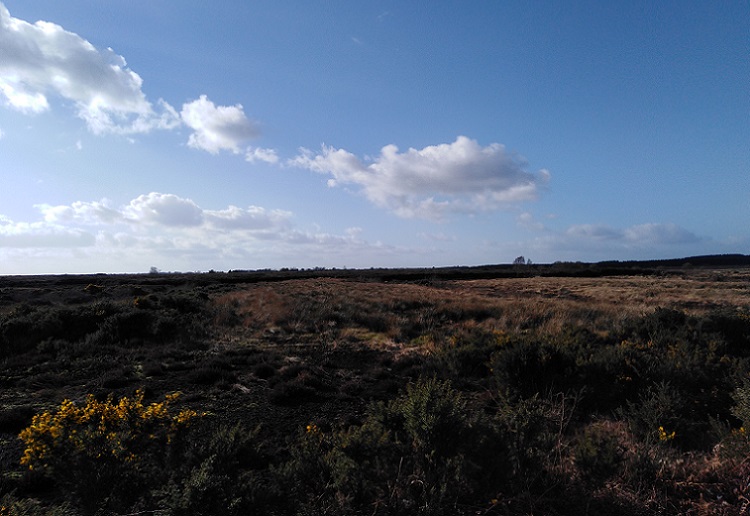Out Here | 4 | In the Land of the Landlords
Stones crunch under my feet as I step off the main road onto the track that jackknifes into the bog. The land is flat. And the wind has swept the clouds from the sky so that the horizon is a clear blue. It comes to rest on the distant hills, unblemished by clouds or pollution. I stop, take a picture, listen to the wind. The heather shivers at its touch. But otherwise everything is still. The commuters are at work so there is nothing to disturb this place – the hinterland between Ireland’s coasts. A place that lies unseen on either side of the motorway from Galway to Dublin.
I leave the main road behind as I turn a bend in the track. Across the bog there are houses, each standing far apart from the next. Between them lies Ireland’s patchwork of farmland. Irregular shapes divided by the stone walls that the Americans love.
Once those fields would have been owned by landlords. And the people who worked and lived on it had no claim to it. A few miles away, past the next village up, there is a memorial to the 4,000 people evicted from their homes by the Gerrard family. In a report in 1846’s Freeman’s Journal – a year into the Great Famine – a local man calls Mrs Gerrard “the greatest exterminator of tenantry in this country.” And says she has turned the land “into bullock pastures.” People were forced from their homes. And replaced with cattle.
I walk to the end of the track, where a sump has been dug out of the bog and filled with brown water, and I stop. The countryside stretches away from me for miles. Crisscrossed by the roads that join rural Ireland’s villages and dotted with houses. Many of them stand unfinished. They were started during the Boom and are only shells on the sites that cost fortunes. There’s a house up the Galway road that is empty and big enough to be a hotel. No one lives there. The drive is overgrown. Almost invisible in the grass that creeps up to the front door. Which looks out onto the road, a stab of red in the house’s unpainted front.

Ireland’s people were denied money and ownership rights by those same landlords that cast them out from their homes. So we lost our minds when the money came in after hundreds of years of being forbidden and unable to own anything. Out of nowhere our floors turned to marble and our sinks had gold taps. Our cars doubled in size, our cities started to encroach on the country, and we all became addicted to cappuccinos. None of these things are wrong. Modernity comes for us all. And we can embrace it or become hermits. But Ireland’s relationships with money and modernity are as toxic as deadly nightshade. We let them rule us. So that instead of building the country up, we tore it down. With the same tools that tiled those marble floors and put fuel in our cars.
When the money was taken away we were left wandering our sprawling houses, wondering what happened. As if we had woken up one morning and found the other side of the bed empty and cold. So the country came to a screaming halt. Projects were left unfinished, people without jobs, housing estates rotting and vandalised. We are building the country back up again – brick by brick. But if the money were to reappear in our pockets, history would repeat itself. For ownership is ingrained in Ireland’s consciousness.
We are fixed on the idea of possessing. Just because we could not do so for hundreds of years. In Ireland possession is a sign of status – that you are a somebody in this world. When your stuff spills out the doors of your house and you can take up two parking spaces with one Land Rover, you know that you have made it. “I own therefore I am,” is our philosophy. And we adhere to it as faithfully as the prayers that we were taught in school.
The wind cuts through my coat and I thrust my hands into my pockets. I turn around and head back the way I came. Away from the bog and the panoramic view and back to the main road that is starting to come alive as evening closes in. And the people return to their houses.
Featured Image Source: James Fleming
